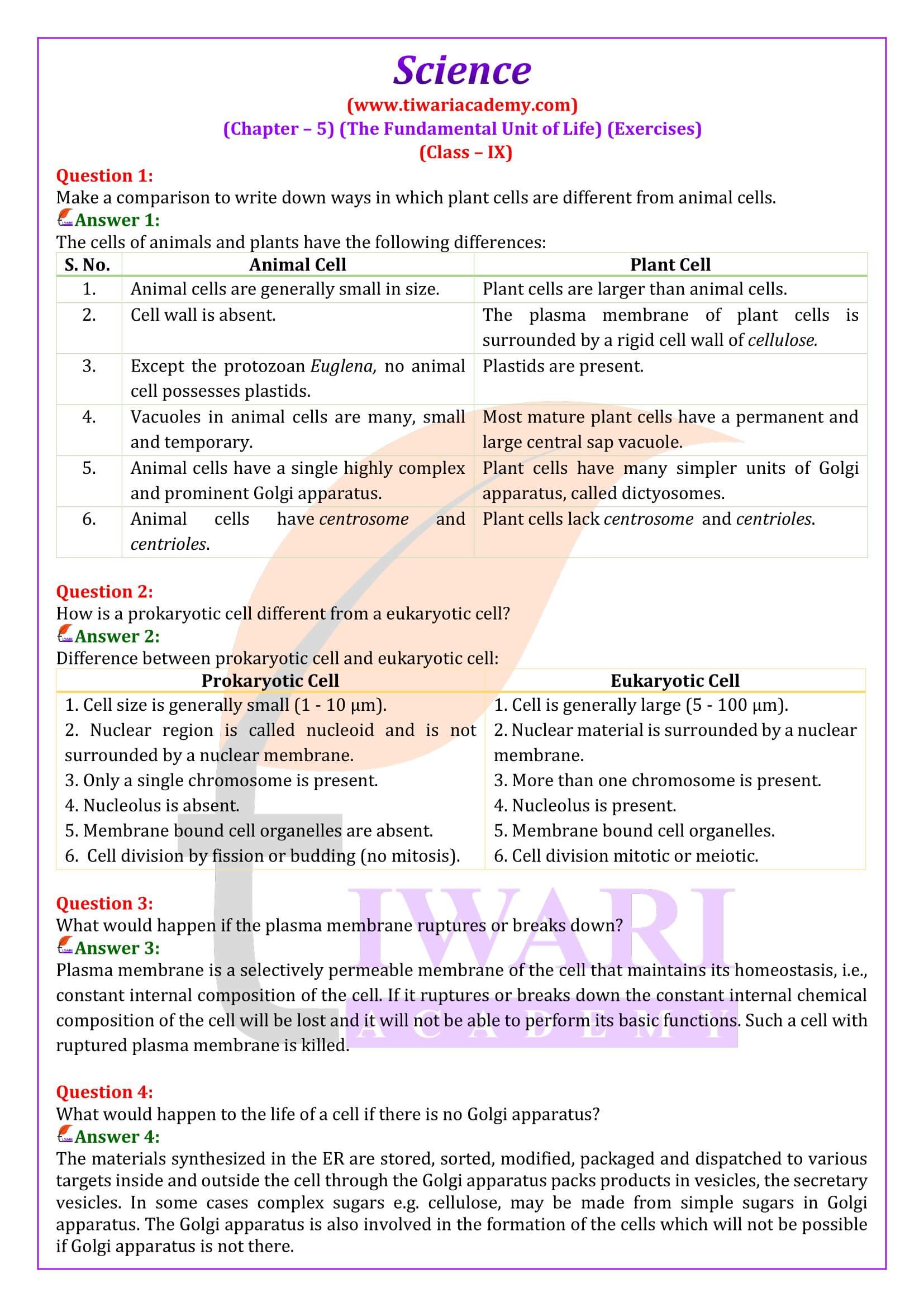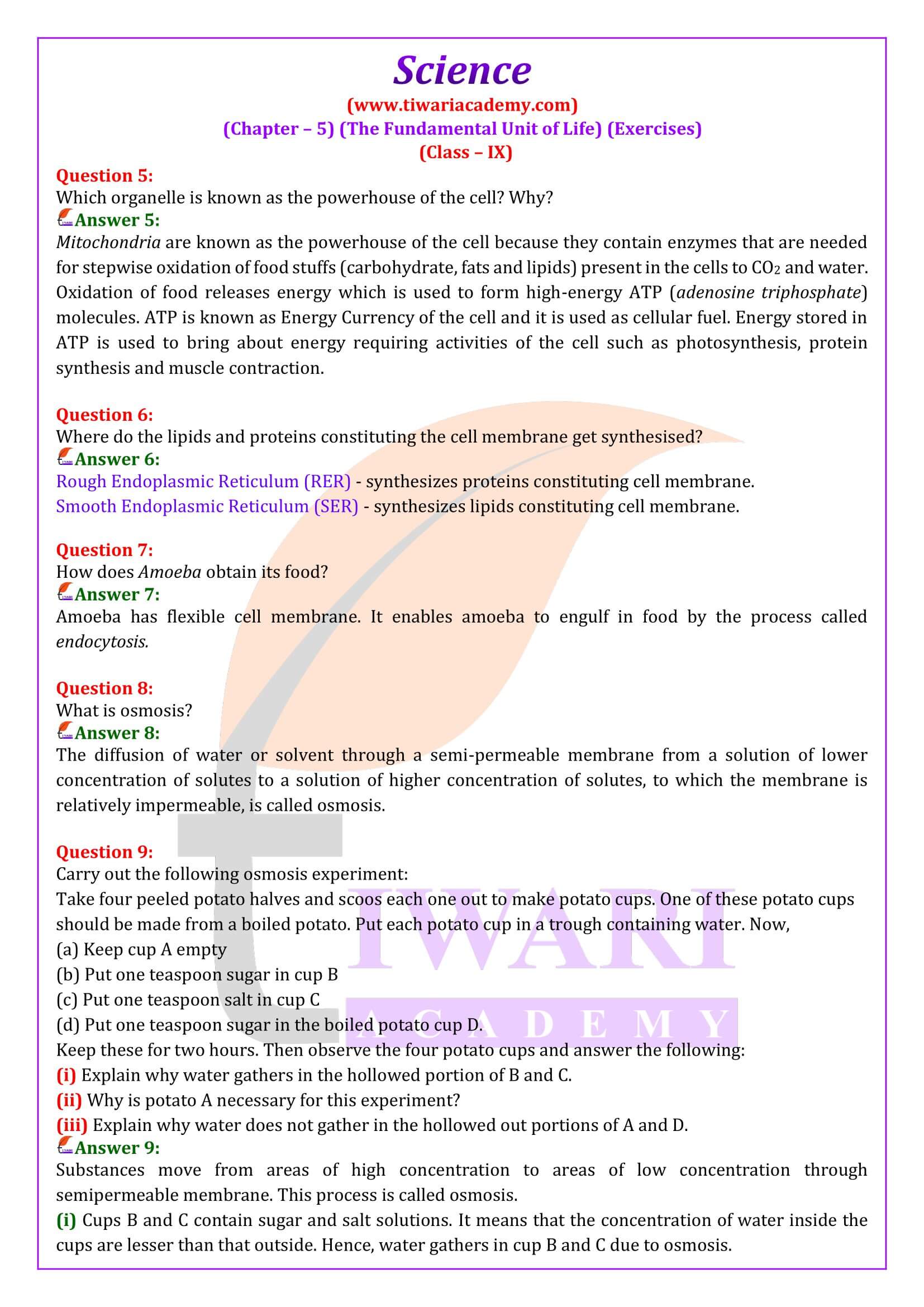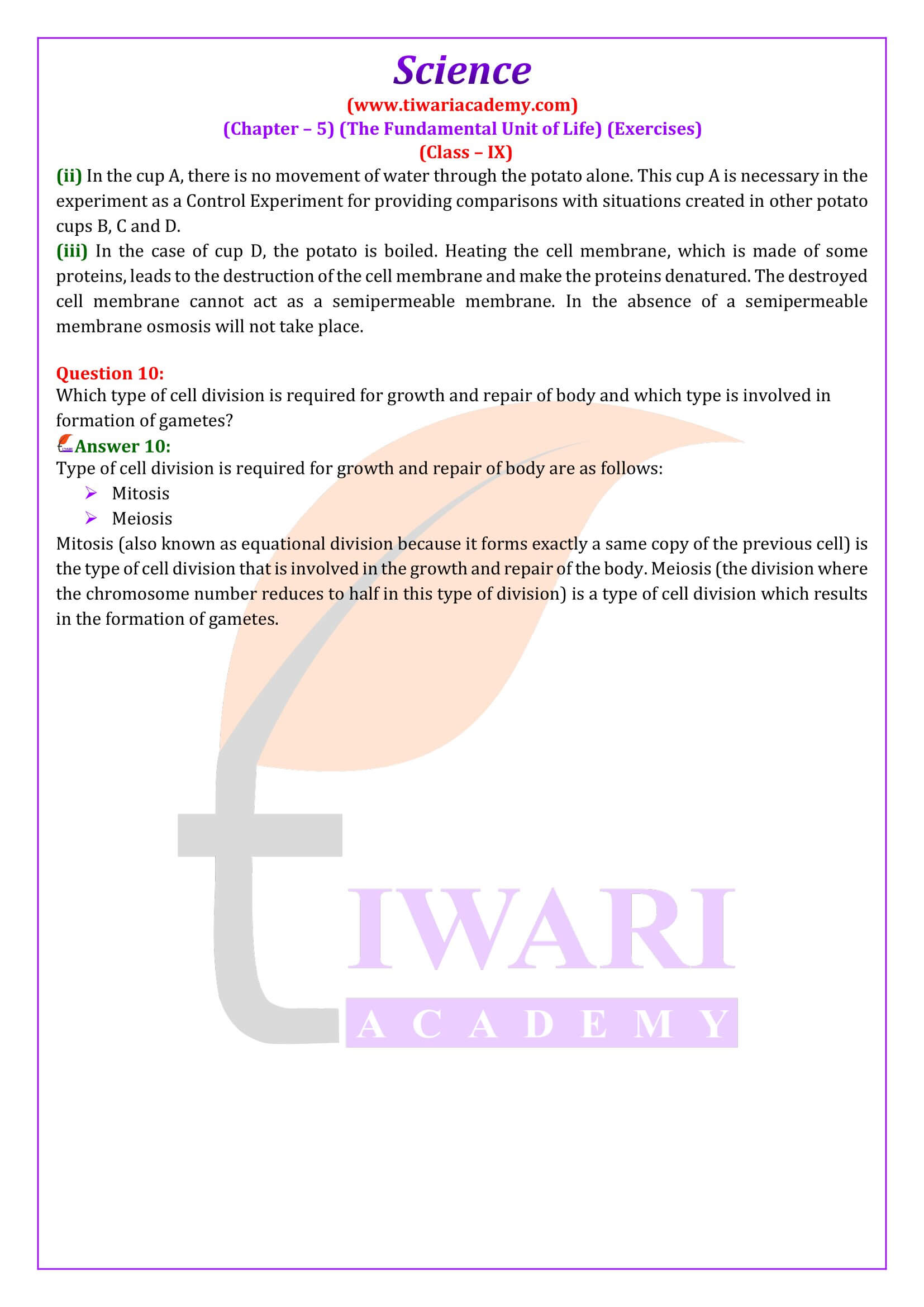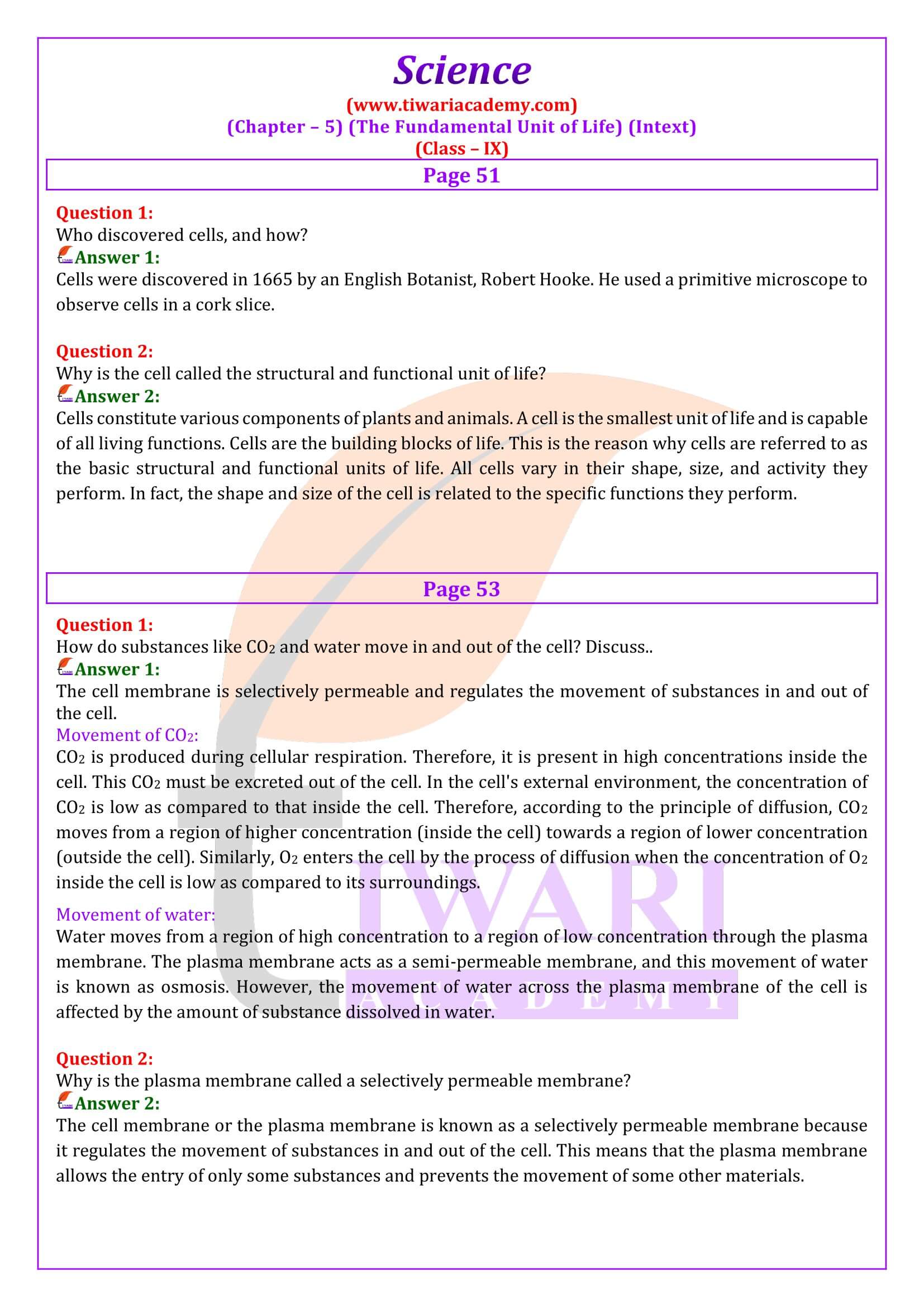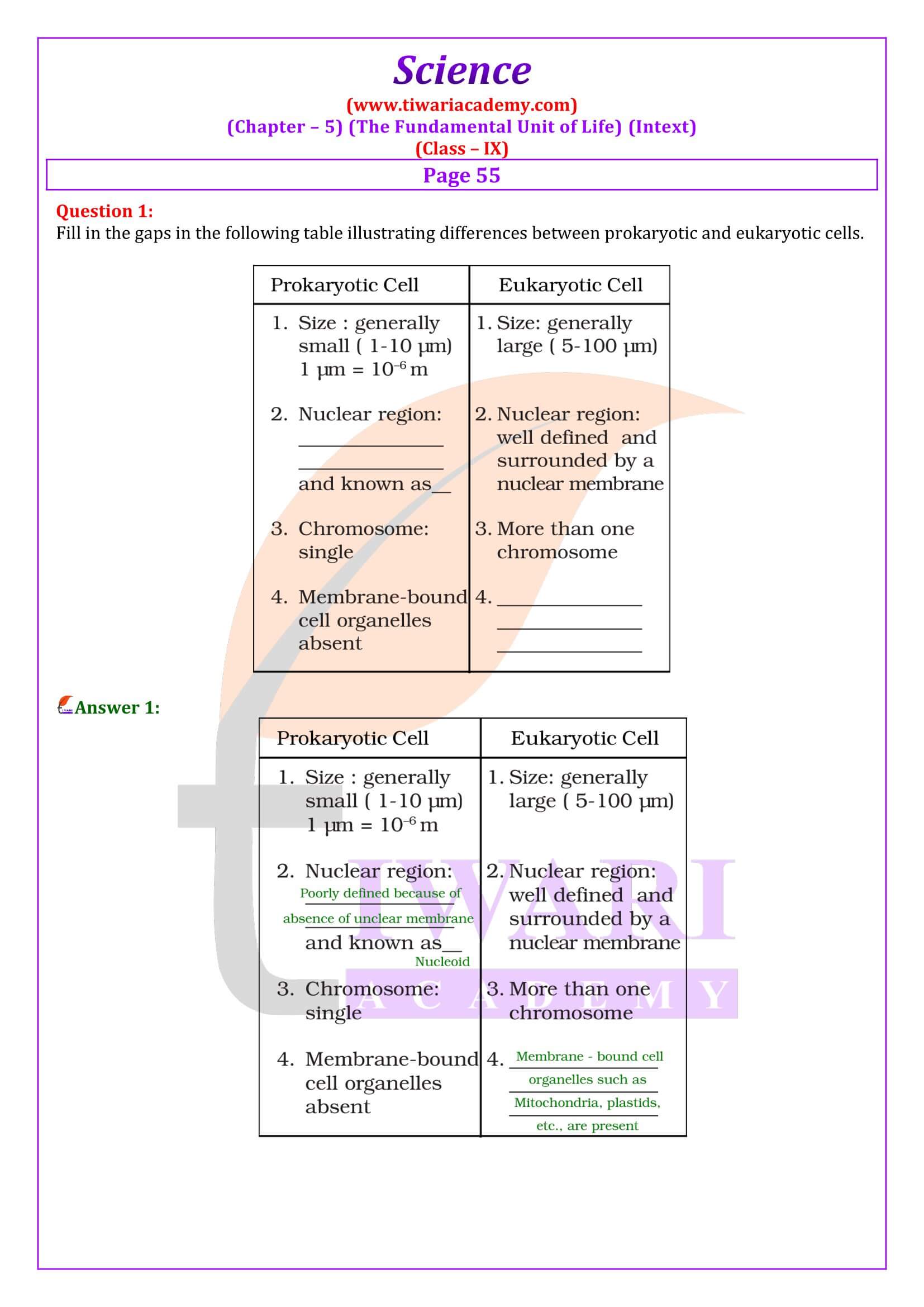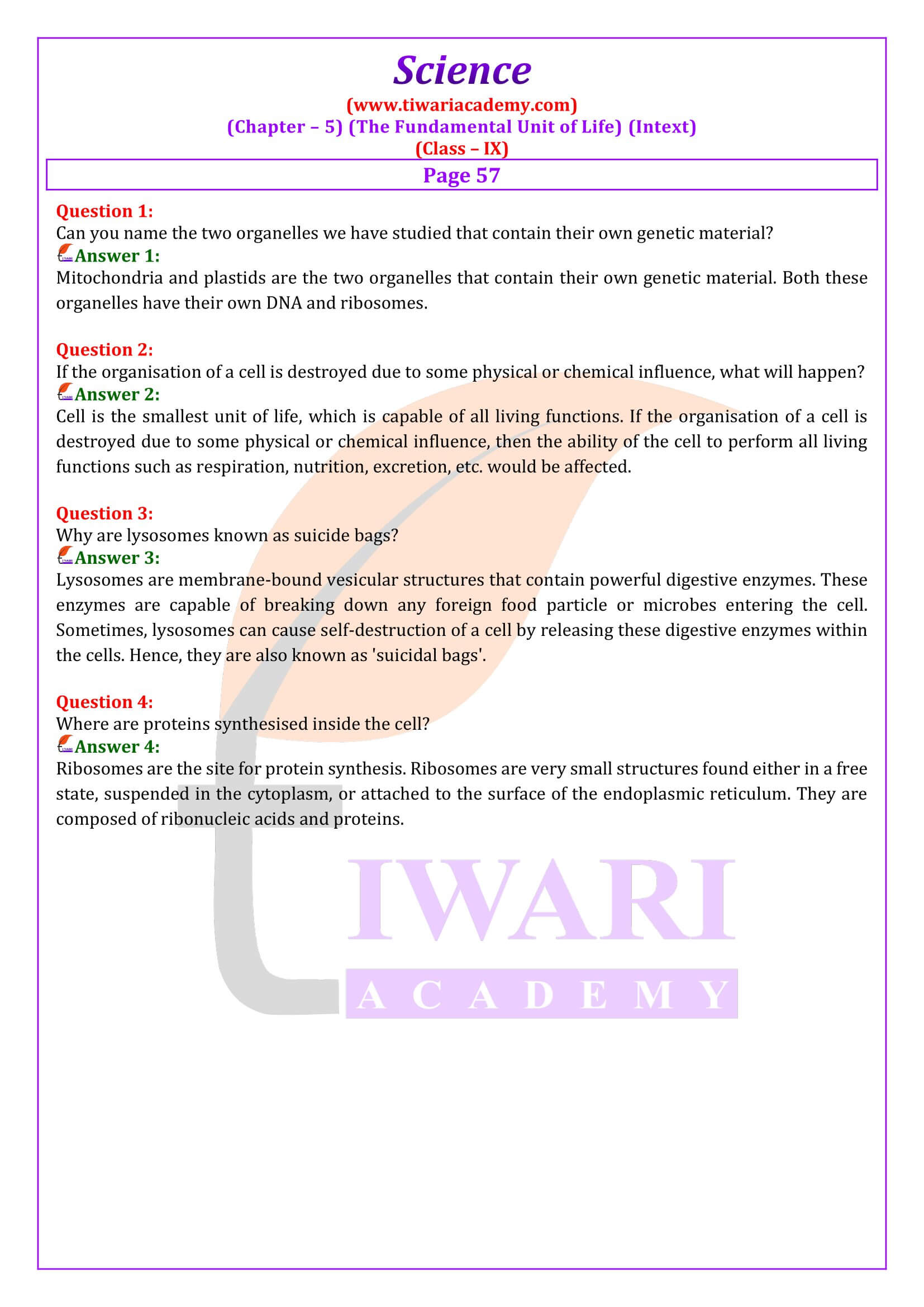NCERT Solutions for Class 9 Science Chapter 5 Updated for New Session 2025-26, The fundamental unit of life in Hindi and English Medium. The Textbook solutions of class 9 Science chapter 5 is modified and updated according to new NCERT textbooks published for academic year 2025-26.
Class 9 Science Chapter 5 Question Answers
- Class 9 Science Chapter 5 Exercises
- Class 9 Science Chapter 5 Intext Questions
- Class 9 Science Chapter 5 MCQ
- Class 9 Science Chapter 5 Extra Questions
- Class 9 Science Chapter 5 Hindi Medium
- Class 9 Science Chapter 5 Notes in English
- Class 9 Science Chapter 5 Notes in Hindi
- Class 9 Science Chapter 5 NCERT Book
- Class 9 Science NCERT Solutions
- Class 9 all Subjects NCERT Solutions
Class 9 Science Chapter 5 Question and Answers
NCERT Class 9 Science Chapter 5 the Fundamental Unit of Life covers about the living organisms made up of, there cell made up of and structural organization of a cell. It also explains about Cell wall, plasma membrane, cytoplasm, nucleus, cell organelles, mitochondria, endoplasmic reticulum, Golgi apparatus, lysosomes, vacuoles plastids. The chapter 5 of class 9 science also discusses the different types of cells (prokaryotic and eukaryotic) and the differences between them. It explains the importance of cells as the structural and functional unit of life.
What are living organisms made up of?
This section discusses the basic characteristics of living organisms, such as growth, reproduction, respiration, excretion, and adaptation. It also explains that all living organisms are made up of cells. What is a cell made up of? This section discusses the basic components of a cell, such as the cell membrane, cytoplasm, nucleus and organelles. It also explains the different types of cells, such as prokaryotic cells and eukaryotic cells.
Class IX Science chapter 6 answers given on Page 59, Page 61, Page 63, Page 65 and Exercises in English Medium updated for new academic session 2025-26 based on latest 9th NCERT Books.
What is the Structural Organization of a Cell?
This section in 9th science discusses the arrangement of different components inside a cell. It explains the role of the cell membrane in protecting the cell and regulating the movement of substances into and out of the cell. It also discusses the role of the nucleus in controlling the cell’s activities and the role of organelles in carrying out different functions within the cell. Cell Wall This section discusses the structure and function of the cell wall, which is found only in plant cells. It explains how the cell wall protects the cell and gives it shape.
Download UP Board Solutions class 9 Science chapter 5 in Hindi medium. Hindi Medium versions of Chapter 5 Page 66 ke Uttar or Page 68 ke Uttar or Page 70 ke Uttar or Page 73 ke Uttar and Abhyaas ke Uttar are also available in PDF form to free download. Download NCERT Solutions 2025-26 and NCERT Solutions Apps for all subjects based on latest NCERT Books. We have updated our contents for CBSE, UP Board, Gujrat Board, MP Board and other boards who are following latest CBSE Syllabus.
Plasma Membrane and Cytoplasm
This section discusses the structure and function of the plasma membrane, which is found in all cells. It explains how the plasma membrane protects the cell and regulates the movement of substances into and out of the cell. We also discusses the cytoplasm, which is the jelly-like fluid that fills the cell. It explains how the cytoplasm contains all of the cell’s organelles and how it supports and protects the organelles.
Nucleus and Cell Organelles
We will learn here about the nucleus, which is the control center of the cell. It explains how the nucleus contains the cell’s DNA and how it controls the cell’s activities. Cell Organelles section discusses the different types of cell organelles and their functions. It explains the role of Mitochondria in producing energy, and the role of the endoplasmic reticulum in protein synthesis and transport.
The role of the Golgi apparatus in packaging and secreting proteins, the role of lysosomes in breaking down food and waste products, the role of vacuoles in storing water and other substances and the role of plastids (chloroplasts and leucoplasts) in photosynthesis and food storage.
| Class: 9 | Science |
| Chapter 5: | The fundamental unit of life |
| Contents: | Intext and Exercise Solutions |
| Mode of Content: | Text, Videos and PDF Format |
| Medium: | English and Hindi Medium |
The chapter 5 of 9th science includes a number of diagrams and illustrations to help students understand the different concepts discussed. It also includes a number of questions at the end of the chapter to help students test their understanding of the material.
To prepare for NCERT Class 9 Science Chapter 5 the Fundamental Unit of Life in a thorough and effective manner, here are some steps and tips. Read the chapter thoroughly, begin by reading the chapter carefully to understand the concepts, terminology and key ideas. Pay attention to headings, subheadings and any bold or italicized text. Understand the concepts and focus on understanding the fundamental concepts of cell structure, functions and different organelles within the cell. Take Notes: As you read, jot down important points, definitions and key terms. Summarize each section in your own words.
Use Diagrams and Illustrations
Draw diagrams and illustrations to visualize the cell structure and organelles. Label the parts and functions, which will help you in better understanding and memorization. Solve the in-chapter exercises and questions provided at the end of the chapter and understand the solutions thoroughly. Refer to additional resources like reference books, online resources or educational websites Tiwari Academy to supplement your understanding and gather more information on the topic. Watch educational videos related to cell structure and functions. Visual aids can enhance your comprehension and make the learning process more effective.
9th Science Chapter 5 Answers in English and Hindi Medium
To prepare chapter 5 of class 9 science engage in discussions with classmates, study groups or teachers to clarify doubts, exchange ideas and gain different perspectives on the topic. Prepare flashcards for important terms, definitions and key concepts. Solve past year question papers to familiarize yourself with the exam pattern, types of questions asked and to improve your time management skills. Take online quizzes or practice tests related to the chapter. Maintain a study schedule and allocate specific time slots in your study schedule for each topic or sub-topic. Stick to the schedule to cover the chapter thoroughly.
NCERT Solutions for Class 9 Science Chapter 5 The fundamental unit of life Intext questions as well as end exercise question answers are given below for new academic session 2025-26. To solve your doubts, please join the Discussion Forum and ask the questions. Current users as well as our experts will reply you very soon. Download NCERT Solutions Offline Apps for offline use.
Extra Questions on 9th Science Chapter 5
Why are stem cell used in treatment of severe immunodeficiency disorder (SCID) in the children? Give three reasons.
(i) These are capable of dividing for long periods to generate replacement for the cell which that cannot produce adenosine deaminase.
(ii) Stem cells can trigger immune response.
(iii) Stem cells can differentiate into white blood cells against the infectious diseases.
Why is the cell called the structural and functional unit of life?
A cell is a smallest part of the living organisms which is fully alive and is capable of performing basic processes of life like, reproduction and respiration, therefore, it is called the structural and functional unit of life.
Name a single cell which may constitute a whole organism. What are they called?
Amoeba, They are called Unicellular organism.
Every multi-cellular organism has come from a single cell. Justify the statement.
Single cell forms a zygote which is first cell formed after fertilization. It further leads to the formation of large number of cells by cell division.
Which functions are performed by a single cell organism like amoeba?
A single cell takes in food, excrete waste, move, grow and reproduce.
Who discovered the cell and how?
Robert Hooke saw the cork which resembled the structure of a honey comb consisting of many little compartments. He observed these through a microscope. He called these boxes as cell.
Why is plasma membrane called a selective permeable membrane?
It is because it allows only certain material to pass through it and not all the materials.
Can you name the two organelles which contains their own genetic material?
(i) Mitochondria
(ii) Chloroplast
Set aside time for regular revision of the chapter to reinforce your understanding and retain the information for a longer period. Don’t hesitate to ask your teacher or a knowledgeable person if you have any doubts or concerns regarding the chapter. Keep your study materials, notes and resources well-organized to facilitate easy access and efficient studying. By following these steps and strategies, you can prepare for NCERT Class 9 Science Chapter 5 effectively and perform well in exams. Understanding the fundamental concepts and having a strong foundation in this chapter will also benefit you in your future studies in science.
Questions for Practice on 9th Science Chapter 5
Tiwari Academy is an online educational platform that offers study materials, resources, and guidance to help students prepare for various academic subjects, including NCERT Class 9 Science Chapter 5 (The Fundamental Unit of Life). Here are some common ways educational platforms like Tiwari Academy typically assist students in preparing for NCERT Class 9 Science Chapter 5. Tiwari Academy provides comprehensive study materials for Class 9 Science, including notes, summaries, important questions, video lectures and solutions for Chapter 5. These resources can help students understand the concepts and topics more effectively.
The detailed solutions to the exercises and questions at the end of Chapter 5 are available here. These solutions aid in better understanding and clarity of concepts. Video lectures explaining the concepts of Chapter 5 can be available on Tiwari Academy. Visual learning through videos can enhance understanding and retention of the subject matter. Tiwari Academy offers a variety of practice questions, quizzes and interactive exercises related to Chapter 5. This helps students in practicing and assessing their knowledge.
Question 1:
How do substances like carbon dioxide and water moves in and out of the cell? Discuss.
Answer 1:
It takes place through diffusion from higher concentration to lower concentration across a cell membrane.
Question 2:
Where are proteins synthesized inside the cell?
Answer 2:
Packaging, storage and dispatching of the materials, synthesized inside the cell will not take place.
Concise and well-structured revision notes be provided, allowing students to quickly review important points from Chapter 5 before exams. Question banks with a wide range of questions related to the chapter are often made available. This helps students in preparing for examinations by practicing different types of questions. Tiwari Academy offers tips, strategies and guidance on how to effectively study Chapter 5, manage time and prepare for exams.
Question 3:
What will happen when a human red blood cells is placed in hypertonic salt/sugar solution?
Answer 3:
It will shrink, i.e., plasmolysis will take place.
Tiwari Academy provides doubt resolution services, named Discussion Forum, where students can ask questions and get their doubts clarified by subject matter experts or teachers. The online nature of Tiwari Academy allows students to access the study materials and resources at their convenience, enabling flexible and self-paced learning. It is important for students to explore the Tiwari Academy platform themselves to fully understand the range of services and resources available for Chapter 5 of NCERT Class 9 Science.
NCERT Class 9 Science Chapter 5 the Fundamental Unit of Life holds significant importance from an examination point of view. Chapter 5 introduces students to the basic unit of life, the cell. Understanding this fundamental concept is very useful for comprehending higher-level biological concepts. Examinations often test this foundational understanding. Many biological concepts and terms introduced in this chapter are foundational for higher classes. A solid grasp of these concepts is essential for success in future biology courses and examinations.
Important Questions on 9th Science Chapter 5
What would happen if the plasma membrane ruptures or breaks down?
Plasma membrane is a selectively permeable membrane of the cell that maintains its homeostasis, i.e., constant internal composition of the cell. If it ruptures or breaks down the constant internal chemical composition of the cell will be lost and it will not be able to perform its basic functions. Such a cell with ruptured plasma membrane is killed.
What would happen to the life of a cell if there is no Golgi apparatus?
The materials synthesized in the ER are stored, sorted, modified, packaged and dispatched to various targets inside and outside the cell through the Golgi apparatus packs products in vesicles, the secretary vesicles. In some cases complex sugars e.g. cellulose, may be made from simple sugars in Golgi apparatus. The Golgi apparatus is also involved in the formation of the cells which will not be possible if Golgi apparatus is not there.
Which organelle is known as the powerhouse of the cell? Why?
Mitochondria are known as the powerhouse of the cell because they contain enzymes that are needed for stepwise oxidation of food stuffs (carbohydrate, fats and lipids) present in the cells to CO2 and water. Oxidation of food releases energy which is used to form high-energy ATP (adenosine triphosphate) molecules. ATP is known as Energy Currency of the cell and it is used as cellular fuel. Energy stored in ATP is used to bring about energy requiring activities of the cell such as photosynthesis, protein synthesis and muscle contraction.
Where do the lipids and proteins constituting the cell membrane get synthesised?
Rough Endoplasmic Reticulum (RER) – synthesizes proteins constituting cell membrane. Smooth Endoplasmic Reticulum (SER) – synthesizes lipids constituting cell membrane.
How does Amoeba obtain its food?
Amoeba has flexible cell membrane. It enables amoeba to engulf in food by the process called endocytosis.
What is osmosis?
The diffusion of water or solvent through a semi-permeable membrane from a solution of lower concentration of solutes to a solution of higher concentration of solutes, to which the membrane is relatively impermeable, is called osmosis.
The chapter 5 of 9th science usually carries a fair weightage in examinations. Questions related to cell structure, functions and related topics are likely to be included in tests and exams. Questions in exams may require students to apply their understanding of cell structure and functions to various scenarios. Being well-versed with this chapter enables them to answer such questions accurately. Concepts from this chapter often form the basis for understanding topics in later chapters of the NCERT Science syllabus. Having a strong foundation in Chapter 5 helps in comprehending subsequent chapters effectively.
Knowledge gained from chapter 5 class 9 science is not only important for exams but also has real-world applications in various fields like medicine, genetics, biotechnology and more. Understanding cells is essential for understanding the biological basis of life and its applications. Exams may include questions where students are required to draw and label diagrams of cells and cell organelles. Practicing this skill is essential for scoring well in these types of questions. Some exam questions may involve analyzing the functions and interactions of cell organelles. Having a strong understanding of this chapter allows students to approach such questions critically and provide accurate answers.
In some exams, higher-order thinking questions needed, requiring students to synthesize information, draw conclusions or compare concepts related to cells. A thorough understanding of Chapter 5 equips students to handle such questions effectively. In summary, mastering NCERT Class 9 Science Chapter 5 is good not only for exams but also for building a solid foundation in biology. Students should invest time and effort in understanding the concepts, practicing questions and being able to apply their knowledge effectively in various examination scenarios.
